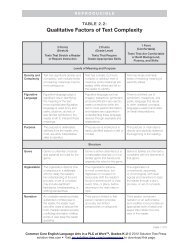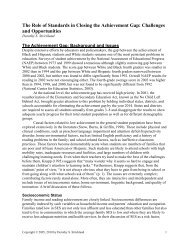Global Education Digest 2012 - International Reading Association
Global Education Digest 2012 - International Reading Association
Global Education Digest 2012 - International Reading Association
You also want an ePaper? Increase the reach of your titles
YUMPU automatically turns print PDFs into web optimized ePapers that Google loves.
SECTION 2 / Learning achievement: Differing policies and practices regarding grade repetition<br />
America and the Caribbean, and the Pacific. Former<br />
French colonies in Africa, for example, tend to follow<br />
the French tradition whereby repetition is applied<br />
to students who fail to make the grade. In North<br />
America, education systems also use repetition<br />
(Labé, 2010).<br />
Repetition is often considered to be a good solution<br />
if learning objectives for that grade level are not<br />
achieved. Usually, repeaters are identified at the<br />
classroom level. The decision to repeat can be taken<br />
unilaterally by the classroom teacher – as in the case<br />
of many developing countries – or after consultation<br />
with the student’s parents, in countries such as<br />
Belgium, France, Switzerland and the United States.<br />
In some West African countries, school principals or<br />
inspectors may also influence the decision.<br />
may also be a ‘culture of repetition’ whereby teachers<br />
tend to fail each year a given proportion of less<br />
performing students irrespective of their learning level<br />
(Crahay, 2007; Labé, 2010).<br />
Learning achievement is not the only criteria for<br />
repetition. A student can also be held back due to<br />
insufficient social or physical maturity in the early<br />
grades of schooling. Moreover, in some cases<br />
students are not promoted simply because the<br />
schools that they attend do not have upper grades or<br />
lack sufficient places to accommodate them.<br />
While accurate data on repetition are essential for<br />
effective educational planning and policy design,<br />
official statistics often under-report the actual<br />
prevalence of repetition due to several factors.<br />
However, the lack of national norms and regulations<br />
has led many experts to argue that these decisions<br />
are based on vague and theoretical learning<br />
standards (UNESCO/IIEP, 1997; Crahay, 2007). In<br />
many cases the decision is based on the teacher’s<br />
evaluation of the student and not necessarily on the<br />
student’s performance on a national or standardised<br />
examination. So the same student may be promoted<br />
by one teacher but held back to repeat a grade by<br />
another teacher. In some countries or schools there<br />
First, the lack of clearly defined concepts of repetition<br />
and sound regulatory mechanisms lead to different<br />
interpretations and standards used at the school<br />
and classroom levels. Students who left or changed<br />
schools during an academic year and enrol in the<br />
same grade the following year are often not counted<br />
as repeaters (Schiefelbein and Wolff, 1992). This<br />
situation is common in developing countries where<br />
the education system is not always equipped to track<br />
these students.<br />
BOX 1. Two key indicators to better examine grade repetition<br />
The two most commonly used indicators for measuring repetition are the repetition rate and the<br />
percentage of repeaters.<br />
The repetition rate represents the proportion of students from a cohort enrolled in a given grade for the<br />
reference academic year who will be in the same grade in the following academic year. It is calculated<br />
at the end of the academic year and is usually based on administrative data. This indicator can be<br />
used to evaluate the internal efficiency of education systems and to project student flows from grade<br />
to grade within the education cycle.<br />
The percentage of repeaters measures the extent and pattern of repetition by grade. It is defined as<br />
the share of repeaters among the total number of students enrolled in a given grade for a reference<br />
academic year. For academic year Y+1, total enrolment in grade X+1 is comprised of new entrants to<br />
that grade (students promoted from grade X at the end of academic year Y) and repeaters that exist in<br />
grade X+1 (i.e. students enrolled in grade X+1 for a second year or more). The percentage of repeaters<br />
is usually calculated at the beginning of the academic year.<br />
For analytical purposes, it is important to note that the repetition rate at grade X refers to academic<br />
year Y, whereas the percentage of repeaters refers to the following academic year (Y+1).<br />
18

















